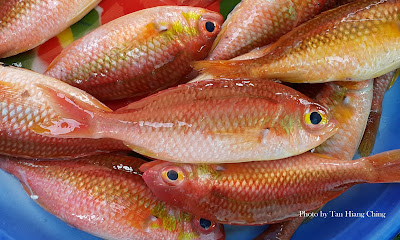Breams (Dwarf Monocle)
Overview
Members of the Nemipteridae family are found mainly in tropical and subtropical waters of the Indo-West Pacific. They are distinguished by having a single continuous dorsal fin, with 10 spines and 9 soft rays, and anal fin with 3 spines and 7 to 8 soft rays. Their colours are extremely variable, but often pinkish or reddish with red, yellow or blue markings.Nemipterids are carnivorous bottom-living fishes feeding mainly on other small fishes, cephalopods, crustaceans, and polychaetes. They can be solitary or schooling and do not appear to be territorial.
Worldwide, there are 5 genera and about 66 species. The 5 genera are Nemipterus (Threadfin Breams), Parascolopsis (Dwarf Monocle Breams), Pentapodus (Whiptails), Scaevius (Coral Breams) and Scolopsis (Monocle Breams).
Dwarf Monocle Breams or Parascolopsis are distinguished from other nemipterids by not having canine teeth in jaws, spine weak or absent suborbital spines, second anal-fin spine usually longer than third spine, and body depth 2.5 to 3 times in standard length. They occur on mud or sand bottoms mainly in offshore shelf waters in depths to about 400 m.
Common Dwarf Monocle Breams Species
Scientific Name: Parascolopsis eriomma (Jordan & Richardson, 1909)
English Name: Rosy Dwarf Monocle Bream
Japanese Name | 和名: アカタマガシラ (Akatamagashira)
Malay Name | Nama Melayu Malaysia: Mempasir Merah Ros, Mempasir Ros Merah, Ikan Pasir
Thai Name | ชื่อสามัญภาษาไทย: ปลาทรายขาวน้ำลึกสีกุหลาบ (Plā thrāyk̄hāw n̂ả lụk s̄ī kuh̄lāb), ปลาทับทิมทะเล (Plā thạbthim thale)
Main Identification Features: Rosy colour on back, diffuse yellow longitudinal band along middle of side, an elongate blotch at origin of lateral line and upper axis of pectoral fin black. Pectoral and caudal fin yellowish.
Size: Maximum standard length 25.5 cm, commonly to 20 cm.
Habitat and Ecology: Offshore associated with rocky and soft bottoms, 25 to more than 250 m depth. Non-migratory. Feeds mainly on benthic invertebrates.

